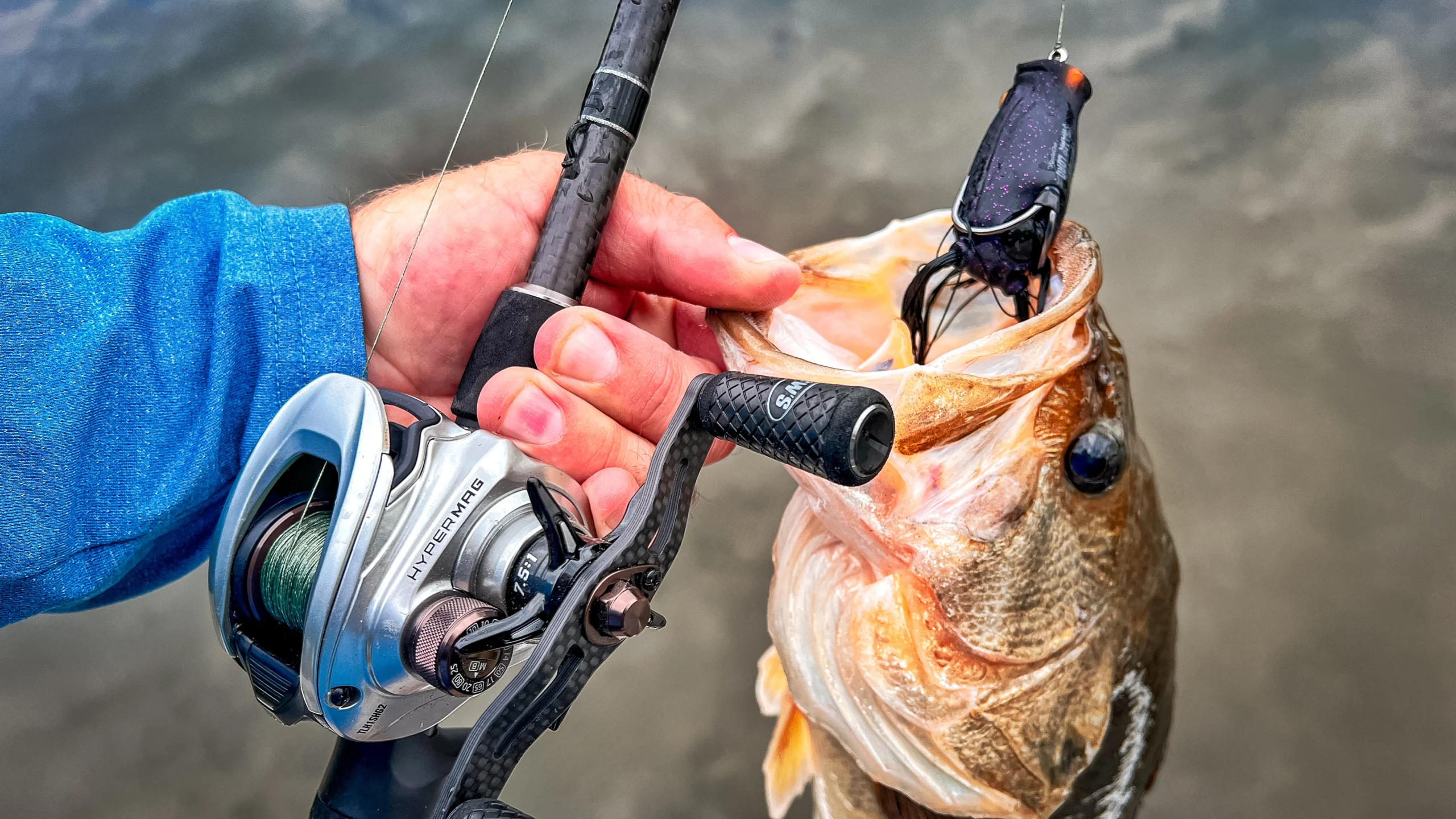There are three main types of fishing line used for bass fishing: monofilament, fluorocarbon, and braided lines. These three fishing line types all have some things in common as well as some differences. And this inherently means that some of these lines are better suited for certain techniques than others. But all have their place, but deciding on fluorocarbon vs braid for some situations isn’t so easy.
In the past we’ve examined the key differences between braided line and monofilament and we’ve pitted fluorocarbon against mono, but we haven’t yet compared the pros and cons of braided line and fluorocarbon, so let’s get to it.
Deciding which line to go with in any given situation can be a little tricky, and multiple factors usually have to be considered.
But, if you keep this resource handy and remember the basic characteristics of each line, you can select the best line to use when looking at braid vs fluorocarbon.

Fluorocarbon vs Braid: Key Differences
- Braid floats, fluorocarbon sinks
- Braid is high vis, fluorocarbon is low vis
- Braid has nearly no stretch, fluorocarbon has minimal stretch
- Braid has less memory, fluorocarbon has more memory
Braided Line: Best Uses
- Heavy vegetation
- Single hook and weedless rigged baits
- Topwaters
- Spinning gear
Fluoro Line: Best Uses
- Heavy wood cover
- Treble hook baits
- Baits that need to get deeper
- Clear water and finesse situations
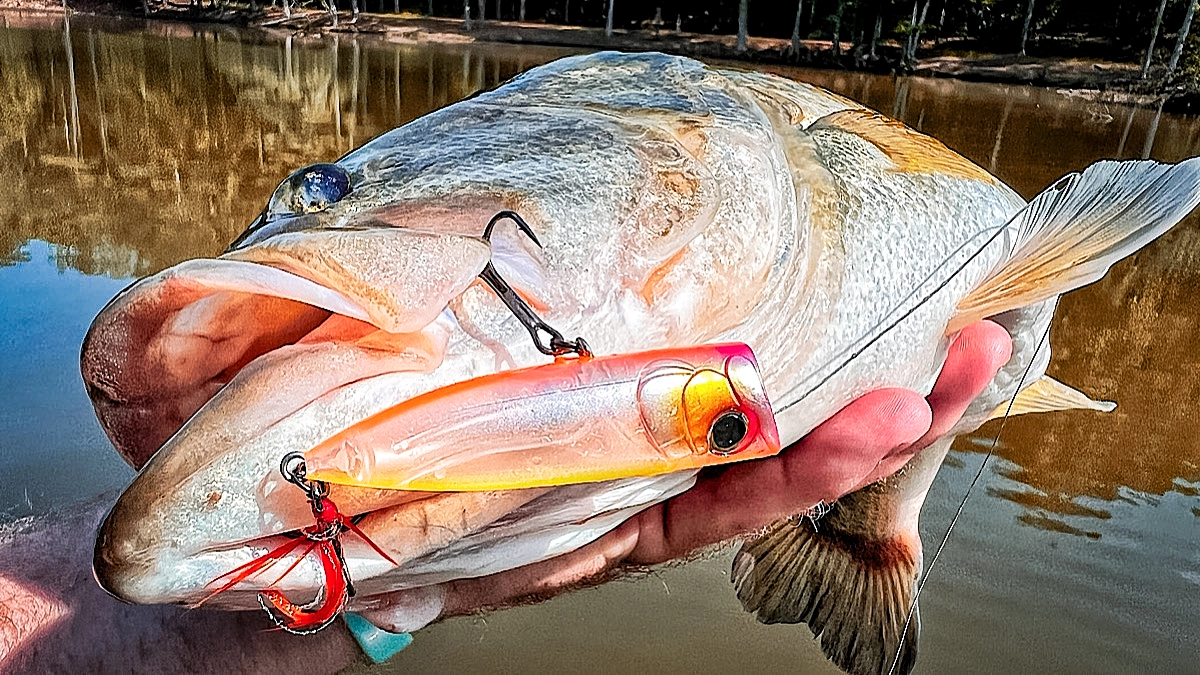
Fluorocarbon Pros and Cons
Pros:
- Minimal stretch
- Sensitive
- Lower visibility
- Sinks
- Abrasion resistant
Cons:
- Sinks
- Lower knot strength
- Harder to tie knots
- More memory
Braid: Pros and Cons
Pros
- Nearly no stretch
- Floats
- Higher knot strength
- Thinner diameter
- More abrasion resistant
- Cuts through vegetation
- Longer casts
- Highly sensitive
- Less memory
Cons
- High visibility
- Nearly no stretch
- Floats
- Digs into wood
- More prone to backlashes
If you need more info on which braided line to choose, you can check out our guide to the best braided fishing lines to find the right one for your application.
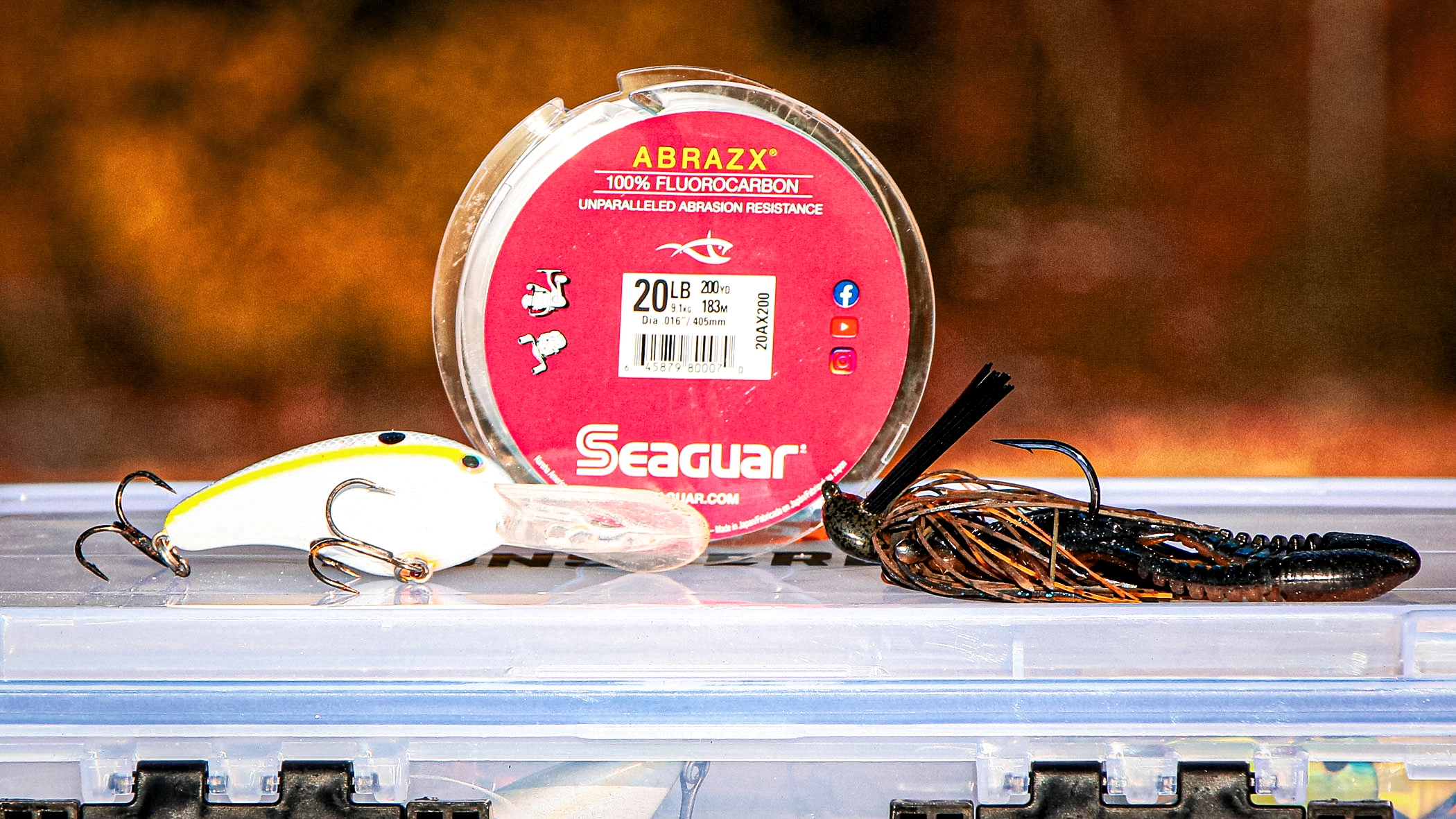
Fluorocarbon vs Braid: The Basics
Tightly woven strands of synthetic fiber are used to form braided line, commonly referred to simply as braid, while fluorocarbon line, or “fluoro,” is made by melting down polyvinylidene fluoride pellets and fashioning them into a single strand.
These two line types differ drastically, but they do have a little in common.
Braid floats and fluorocarbon sinks and braid is highly visible while fluorocarbon has low visibility. But, both of these lines do have way less stretch than monofilament line.
Still, when pitting the two against each other, fluoro does have more stretch than braid for sure.
Thanks to these drastically different characteristics, braid and fluoro can each perform certain tasks better than the other.
When it comes to fluorocarbon vs braid for topwater baits, braid is really good specifically because it floats. Fluoro is much better for crankbaits, because it sinks and allows the bait to get deeper, quicker.

Both types of line cast differently, too. For example, braid has less memory, and so it works better as a mainline on spinning reels because it is much more resistant to the damaging effects of line twists that cause wind knots. Braid is also thinner than fluoro at a higher line-test weight.
At the same time, braid is more prone to backlashes on baitcasters, so you have to take that into consideration and adjust your technique to accommodate.
When to Use Braided Line
Heavy Vegetation
One of the best times to use braid is when you’re fishing around heavy vegetation like water willow, hyacinth, and hydrilla. Braided line is stronger, with up to 80-pound-test commonly used for bass fishing, versus fluorocarbon lines, which max out at 25-pound-test. Braid is also inherently better suited to saw through thick vegetation.
These two attributes make braid the best choice for punching mats, for example. When punching, you may well need to pull a 10-pound bass out of a thick patch of hyacinth, a task that would be unachievable with any other line type.
Then there’s frogging over topped out hydrilla, when it’s often necessary to pull a 6-pound bass in with 20 pounds of vegetation riding shotgun. Even fishing lipless crankbaits and vibrating jigs through submerged vegetation is typically easier with braid, since this line rips these baits free more easily when they get bogged down. So when fishing among heavy vegetation and trying to decide on fluorocarbon vs braid, there’s really no contest.
Single Hook and Weedless Rigs
When it comes to single hook presentations and weedless rigged baits like Texas rigs, jigs, vibrating jigs, toads, and buzzbaits, braided line is often the better choice. With toads, buzzbaits and other topwaters, braid is definitely better, in large part because it floats.
For baits like Texas rigs, vibrating jigs and flipping jigs, braid is again better when fishing around vegetation.
However, there is a case to be made for using braided line when working with single hook baits, even in situations where the baits don’t need to float and you’re not fishing around grass. For example, braided line is great for fishing spinnerbaits, jigs, and Texas rigs in muddy water.
While the line is highly visible, that’s canceled out by the low clarity of the water, but you get the benefits of the line’s high sensitivity, low stretch, and high strength.
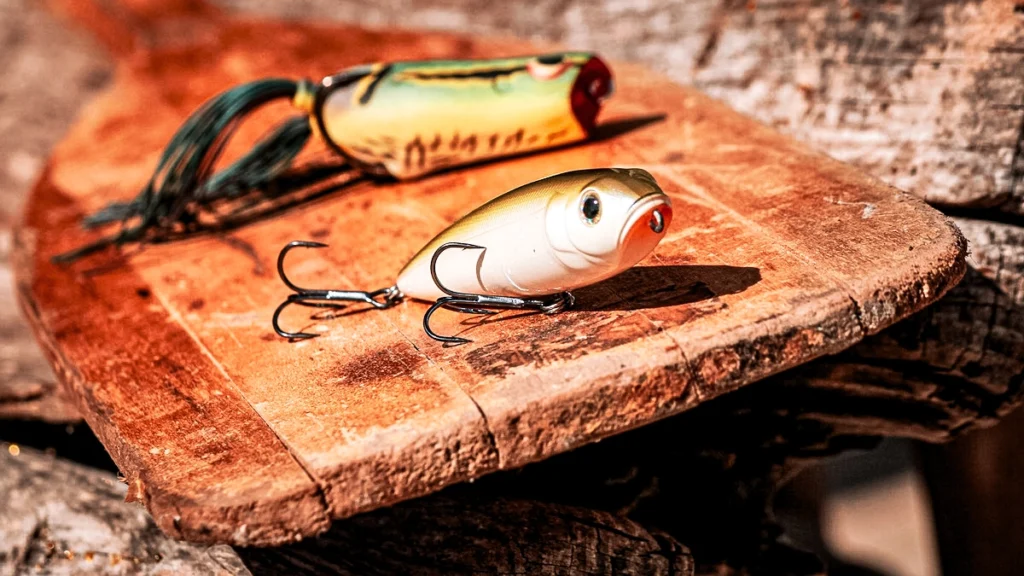
Fishing Topwaters
You want to choose braid over fluoro for topwater baits every time, simply because you need braid’s ability to float, but it goes deeper than that.
Monofilament line also floats and is also a great selection for topwaters, even better than braid sometimes, but that’s another debate.
Our line recommendations for topwater baits with treble hooks will seem contradictory at times. Typically, you’re better off using fluorocarbon with baits that have treble hooks as the stretch it provides helps prevent hooks from pulling. But the fact that braid floats makes it a better choice for topwaters in general. And the added casting distance of the thinner diameter line is a bonus.
When it comes to line recommendations for topwater baits, our advice for baits with treble hooks may seem contradictory at times. Typically, you’re better off using fluorocarbon with baits that have treble hooks for a variety of reasons. We’ll talk more about that in a minute.
But for topwaters with treble hooks like poppers, Spooks, and Whopper Ploppers, the simple fact that braid floats makes it better for these baits. And the fact that it allows you to cast these baits farther is just a bonus.
Spinning Gear
Spinning reels are great for lightweight baits and high-finesse techniques, but they have one inherent downfall: spinning reels are very susceptible to line twists, which develop as a bait spins while flying through the air on the cast or when it spins in the water on the retrieve.
While this happens using both spinning gear and casting gear, it’s a bigger problem for spinning gear, because knots and tangles develop in the line around the eyes of the rod whenever there’s slack in the line, and the line is often slack when using spinning reels.
While braid and fluoro (and mono for that matter) can all develop line twists, it happens way less often with braid. That said, when braid does twist, it can be catastrophic. Because of this, braid is better for the mainline of your spinning reel than fluoro (and mono).
Braid also allows you to cast farther thanks to its thinner diameter and lack of memory, and you can get more of this line on the reel for the same pound test.

When To Use Fluorocarbon Line
Heavy Wood Cover
While braid is better in dense vegetation, fluorocarbon is better around woody cover like flooded bushes, laydowns, and shallow brushpiles.
Braid cuts through vegetation better, but it digs into the wood of branches and sticks like crazy, which can often hang up a bait, or worse, a quality fish that’s trying to bury up in the cover.
Fluoro’s thicker diameter is less likely to cut into wood and get hung up this way.
Treble Hook Baits
Treble hooks have some advantages over big bold single hooks. To name a couple, they offer many more opportunities to connect with the fish and the small hook points and thin wires require far less pressure to puncture a fish’s mouth.
But because they are smaller and thinner, they are also more likely to pull out of fish or bend. Since braided line has essentially no stretch, the give that fluoro provides makes it better for treble hooks than braid. It helps prevent them from pulling out when a fish surges.
While fluorocarbon has less stretch than mono, it still has some stretch — especially when looking at the lighter line options. For instance, a deep diving crankbait on 12-pound fluoro is a lot more forgiving when a fish starts fighting ferociously and tries to tear loose than the same combination would be if it were rigged with 12-pound braid.

You’ll notice, though, that this advice isn’t absolute. Because flouro sinks, it’s not the best choice for topwaters, even those with treble hooks. Braid is also the better option for other rare instances concerning treble hooks, like ripping a lipless crankbait through submerged hydrilla.
The key here when using treble hooks with braid is to use a softer action rod and loosen up your drag, so that the bend of the rod can mitigate the risk of pulling the small hooks out or bending them.
Baits That Need To Get Deeper
Because braid floats and fluoro sinks, fluoro is the better choice for baits that need to get down deep in the water column, like football jigs, Texas rigs, and flutter spoons.
The sinking line creates a better direct contact with these baits, compared to the massive bow that would develop in braided line as it tried to float up. This translates to greater sensitivity and less slack in the line for a more sure hookset.
And there’s also a large benefit to using fluoro with deep-diving crankbaits. The depth range of these lures is lessened by braid as it tries to float up in the water column, whereas the fluoro naturally sinks and offers less resistance, allowing you to get the most depth possible out of your bait. Again, the fluoro is better in this situation anyway, because of the treble hooks.
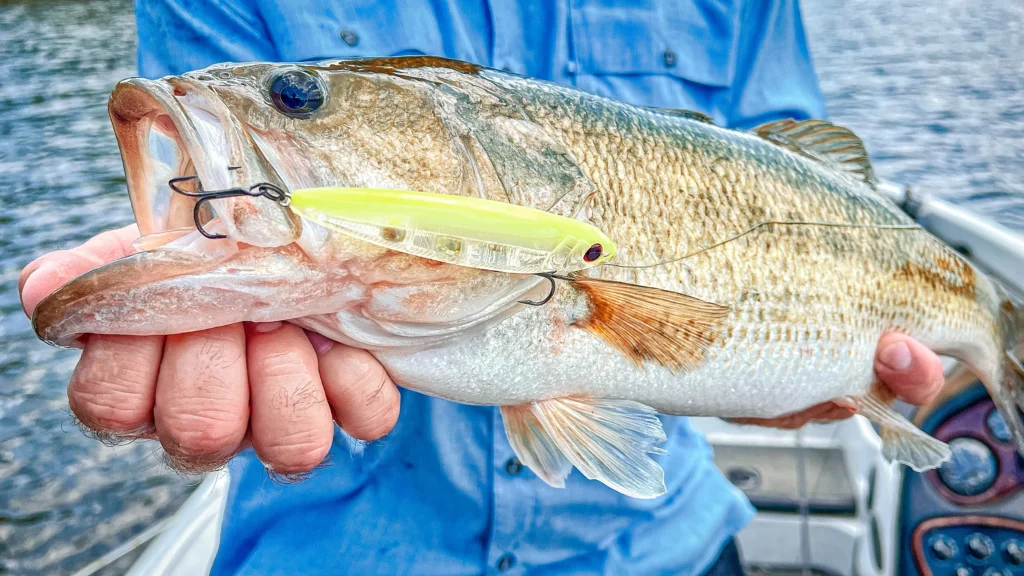
Clear Water and Finesse Situations
Fluoro is also the best choice for clear water and finesse situations because of its low visibility; braid sticks out terribly in ultra clear water. This isn’t a big deal when fishing in muddy water, or even in clear water in dense vegetation, since the line blends in with the blades of grass around it. But in open, clear water or around isolated cover, braid is very noticeable. Fluoro, however, is nearly invisible.
For this reason, fluorocarbon is best for jighead swimbaits, crankbaits, football jigs, and finesse jigs, and it’s best to use this line as a leader for the last few feet before you get to the bait with finesse presentations like Ned rigs, dropshots, Neko rigs, and shaky heads.
Since these finesse baits are all typically fished on spinning gear, using a braided mainline with a fluorocarbon leader is far more effective than straight fluorocarbon line.


